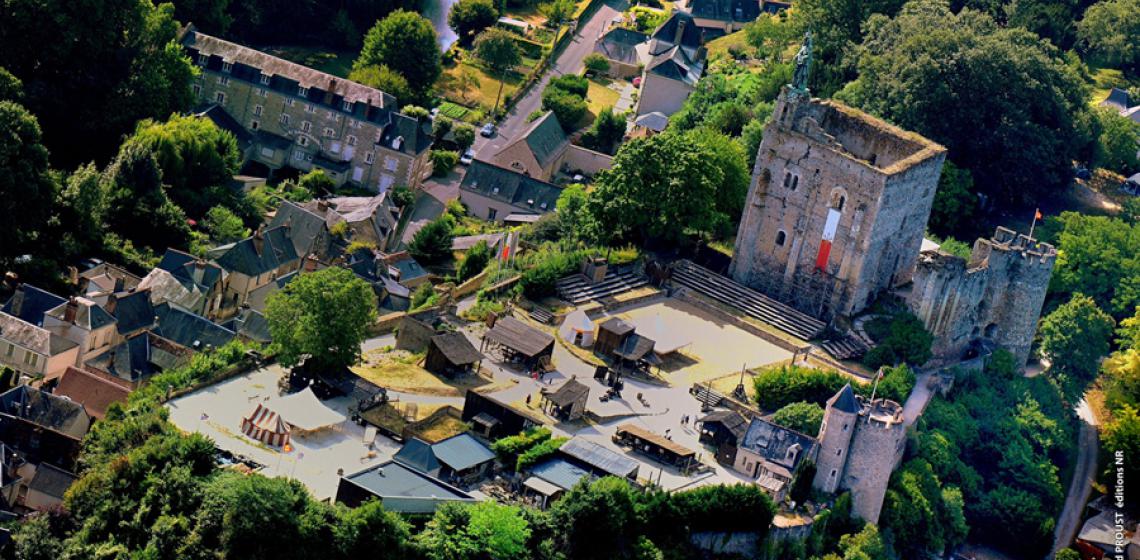
A village brought to life at day and night, with introduction workshops and staged visits. The potter, the basket maker, the weaver, the dyer, the tailor, the calligrapher, the illuminator, the coin engraver, the candle maker, the blacksmith, the saddler, the stone carver, the herbalist, the shingler, the baker and the crossbowman will welcome you in their workshops.
Continual activities, with introduction workshops and staged visits (the donjon, the undergrounds pathways, the torture room and firing the ballistic engines). All year round, the castle opens its gates to the youngest and teaches them history through numerous workshops.
In 1000 AD, an uncommon – almost legendary – person ruled over Touraine, one of the most famous feudal lords of his time, the famous earl of Anjou Foulque III Nerra; nicknamed the “Black Falcon”. Indeed, performing chivalric deeds and insidious crimes, he proved himself to be sometimes cynic, generous, impulsive, scheming or repentant. But first and for all, he was a relentless combatant, spending most of his time fighting his neighbours, particularly his cousin Eudes of Blois, from whom he stole many lands in Touraine.
He set an example for all his feudal lords’ peers by several deeds: the emancipation of the serfs, the protection of the monks, fair sharing, settling familial dynastic issues and keeping a balanced territory. He also set up an educational system, thus reviving the Carolingian traditions.
Over fifty castles, abbeys, churches and monasteries were constructed throughout his long rule. Besides, he went four times on pilgrimage to Jerusalem, in 1003, 1009, 1035 and 1039 AD. He died at 70, when he returned from his fourth journey on the 21th of June 1040 AD in Metz (a town in north-eastern France).
The fortress of Montbazon was built in 991 AD at the top of a rocky spur overlooking the river Indre. The Cormery monks complained to the King of France of Foulque Nerra's behaviour, as he had seized their land. He first build a motte-and-bailey-castle – a wooden donjon on a mound – and later replaced it by a stone donjon. This fortified place forms one of the oldest feudal castles in France. The donjon consisted of a 120 feet-high massive tower, 65 feet long and 50 feet wide. Nowadays, the tower is only 90 feet high. The walls are 9 feet-thick at the ground, and 6 feet-thick at the top of the tower. The south and east frontages are supported by buttresses. The edifice was composed of a cellar and three floors, build in wood and organised according to the class system – the nobles living of the upper floor. The last floor was topped by a hip roof. The entrance of the donjon was located on the north side, at 21 feet from the ground, and was reached thanks to a wooden ladder or a handrail.
The "small keep", or avant-corps, was built against the western wall of the donjon in 1050 by Geoffroi Martel, the Black Falcon's son. In 1154, another heir to Foulque Nerra, Henry II Plantagenet wed Eleanor of Aquitaine, thus becoming the new owner of the Montbazon donjon. King of England and father to Richard Lionheart and John Lackland, he started great construction work which transformed the donjon into a real fortress, as he added crenelated ramparts, the wall walk and the inner yard.
The fortress is then seized by the King of France Philip Augustus in 1205. Following this seizure, numerous changes are brought to the place such as the construction of the ramparts and round towers. The south-western tower is composed of several rooms, whereas the one at the south-east is used as a clamped buttress.
As Montbazon is incorporated to the kingdom of France, the fortress becomes the property of a number of famous families such as the Mirabeau, Savary, Craon, La Rochefoucauld, and finally passing to the Rohan family, the earls of Montbazon at the eve of the French Revolution. Towards the end of the 16th century, the place has yet experienced deep changes. It was in these times that Montbazon became one of the twelve duchy-peerages of the kingdom, and the second richest duchy after Orléans. A second castle was built in 1425, facing the 10th century donjon. The kings of France Charles VII and Louis XI regularly sojourned there. However, in 1746, the castle was demolished and its stones were used to divert the bed of the river Indre (the city council square was edified on the remains of the castle).
Text Source: Fortress website
Photo Source: Fortress website
